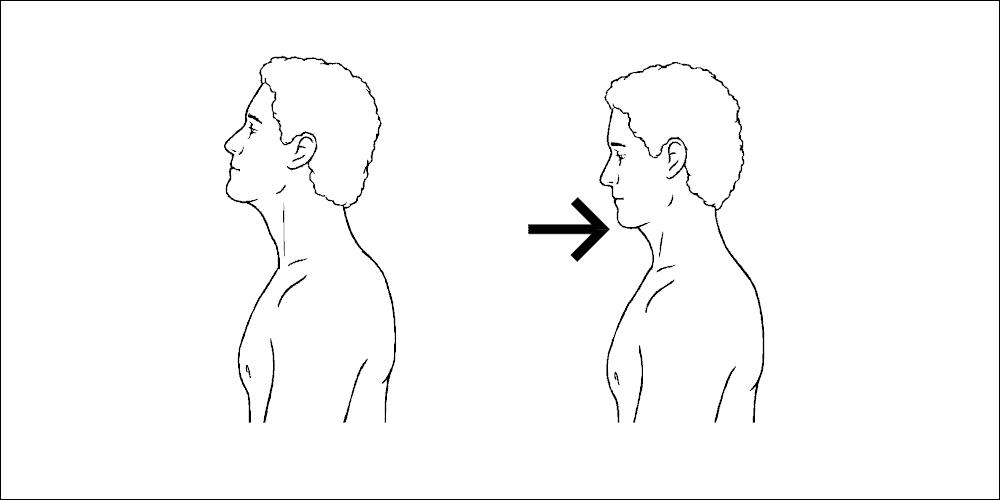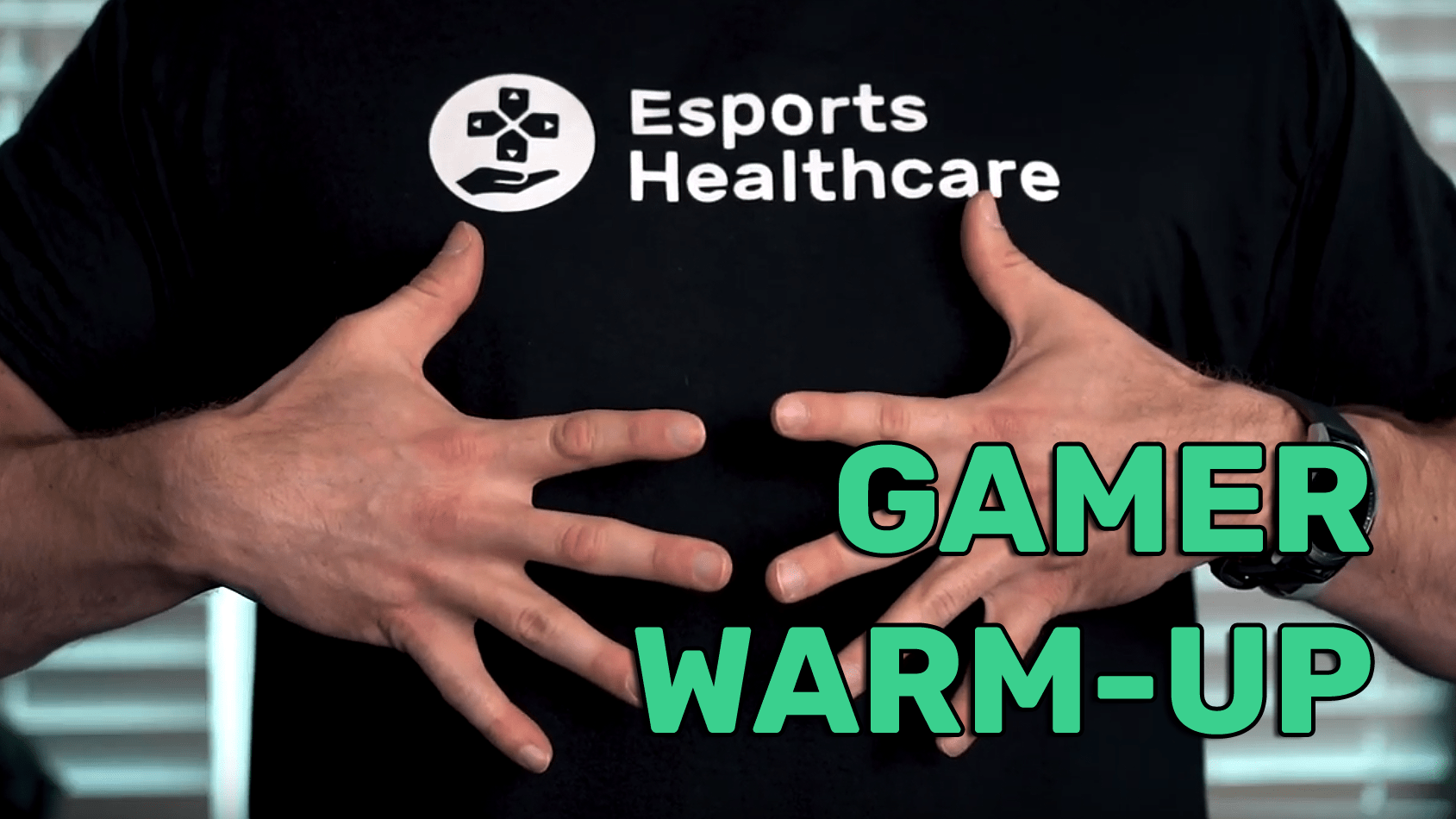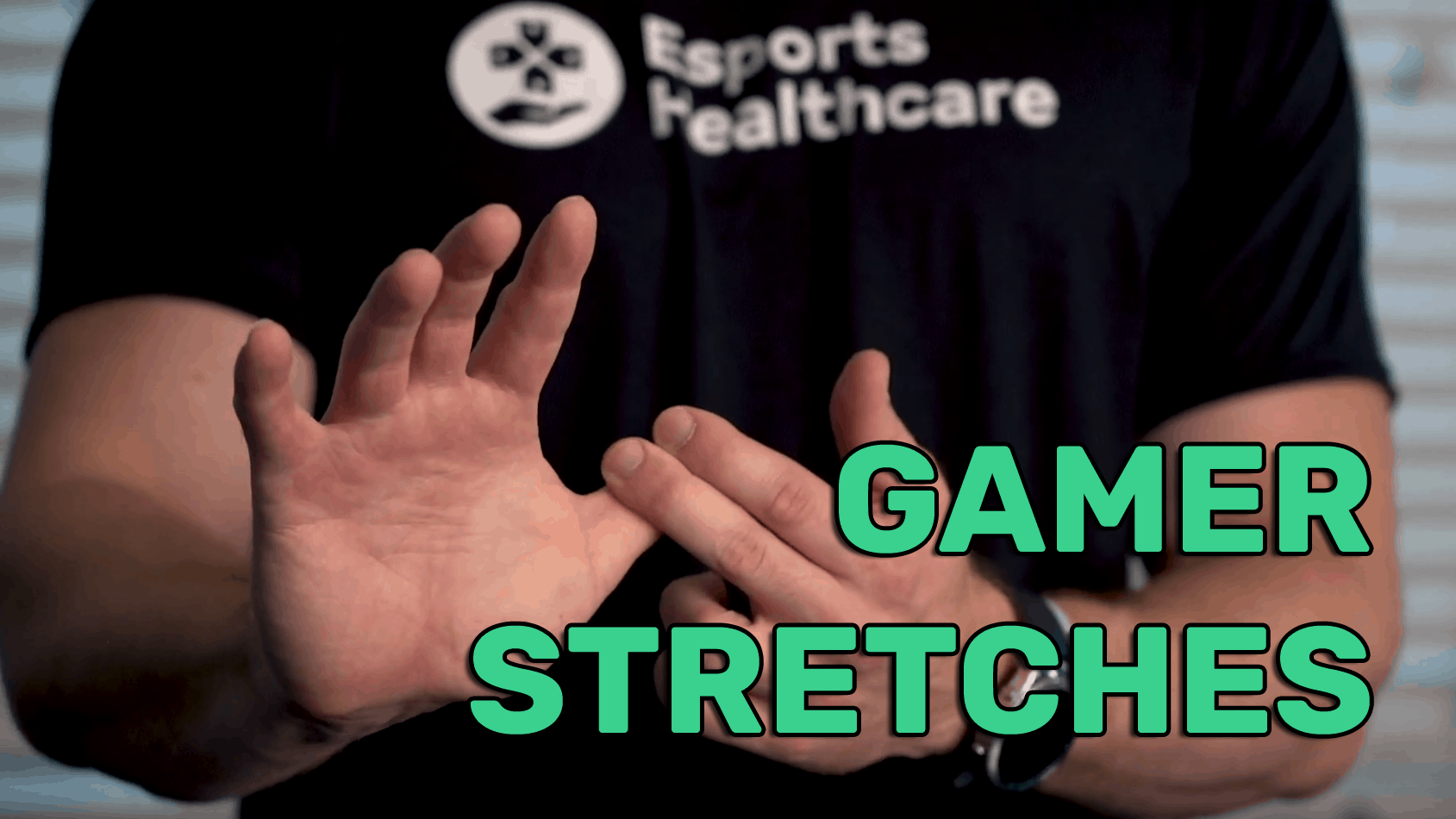Neck pain from gaming, simplified

Key points
Disclaimer
This information is for educational purposes only and is not intended to replace the advice of your doctor. Esports Healthcare disclaims any liability for the decisions you make based on this information.
The information contained on this website does not establish, nor does it imply, doctor-patient relationship. Esports Healthcare does not offer this information for diagnostic purposes. A diagnosis must not be assumed based on the information provided.
Neck pain from gaming is an extremely common occurrence and one that is caused by a variety of factors including injury, poor posture and/or muscular imbalance, and stress. Of course, there are other causes of neck pain; however, for this page we will focus specifically on neck pain from gaming.
Knowing the cause of pain is just as important as the pain itself. Below we will discuss the anatomy of the neck as well as common causes, symptoms, and conditions.
Pertinent anatomy
In order to better understand neck pain from gaming, it’s important to know some basic anatomy of the neck and surrounding regions.
Bony anatomy of the neck
To begin, the region of the neck is known as the cervical spine. In normal anatomy, there are 7 vertebrae—listed in descending order as C1 through C7 (where the letter “C” identifies the cervical spine).
Unlike the joints of your arms and legs, the joints of the spine do not have common names that differ from their anatomical names (e.g., “shoulder” is the common term for the glenohumeral joint). Instead, when describing joints of the spine, we simply list the adjacent segments (e.g., C1-C2 or C5-C6).
Additionally, the first bone of the cervical spine, C1, articulates to the base bone of the skull called the occipital bone. And, despite not technically being part of the neck-proper, the occipital bone is often referred to as “C0,” thus making the name of this joint C0-C1.
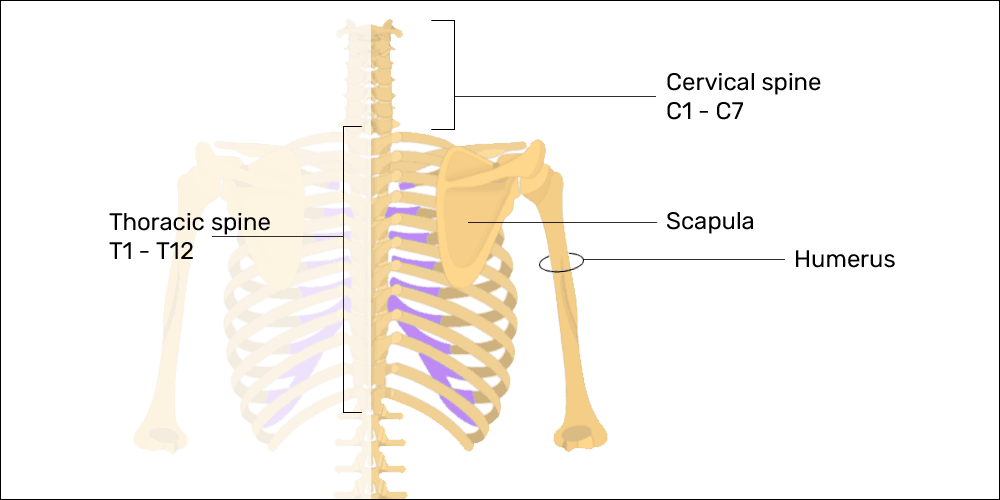
Other non-cervical bones that are important for this discussion include:
- Scapulae: shoulder blades
- Thoracic spine: twelve bones listed in descending order, T1 through T12 (the letter “T” identifies the thoracic spine)
- Ribs: in normal anatomy, there are 2 ribs for each thoracic spine segment—24 ribs in total
- Clavicles: the collar bones
- Sternum: the breast bone
Muscular anatomy of the neck
There are many more muscles of the neck than the few listed below; however, in practice, these muscles tend to be more common sites of pain.
- Upper trapezius: muscles that attach from your scapulae to your cervical spine and occipital bone; these are the muscles at the top of your shoulders most well-known for the action of shrugging, but they can also rotate or tilt your head and neck (2nd image in the scroll below)
- Levator scapula: muscles that also attach from your scapulae to your cervical spine; these are smaller muscles that are also involved in shrugging but can also rotate and tilt your neck
- Sternocleidomastoid: a two-part muscle that attaches from your skull (the temporal bones) to your clavicles and sternum; these muscles rotate or flex (bend forward) your head and neck (2nd image in the scroll below)
- Deep neck flexors: these are smaller muscles that stabilize your cervical spine; they are primarily involved in the chin-tuck action (pulling your head back over your shoulders; the 3rd image in the scroll below)
- Suboccipital muscles: there are four muscles collectively called the suboccipitals. These muscles are located at the back of the skull; they assist with extension and rotation of your head (1st image in the scroll below)
- Cervical paravertebral muscles: namely, iliocostalis, longissimus and spinalis; these muscles primarily hold the spine upright or erect but may also assist in extension (bending back), lateral flexion (side bending), and rotation of the neck
Pathophysiology of neck pain from gaming
The cause of neck pain from gaming varies from person-to-person and may affect different tissue(s). Each individual tissue has a potential to present with unique symptoms. However, sometimes different types of tissue present with similar or overlapping symptoms.
Therefore, it is important that your treating physician truly understands anatomy, physiology, and the nature of video games in order to appropriately diagnose your ailment.
Muscle hypertonicity and trigger points
Muscle tone is in reference to a muscle’s level of contraction or electrical impulse from the nervous system. Normal resting tone means the muscle is not contracting, and a muscle at rest will feel loose and soft to the touch.
Hypertonicity means increased resting tone; a muscle is described as hypertonic when it is engaged in a low-level contraction (elevated electrical impulse from the nervous system) absent of conscious control. A hypertonic muscle will feel tense and firmer to the touch.
A spasm, on the other hand, is a full, unconscious muscle contraction. This is different than hypertonicity and will cause moderate-to-severe pain.
Trigger points are the term used for “knots” in the muscle. The name “trigger point” was given because, when stimulated (e.g., pressure, stretching, or contraction), a trigger point will often give rise to pain elsewhere in the body—known as referred pain.

Sprain injuries: ligament and joint capsule
Although uncommon in terms of gaming injuries, the ligaments or joint capsules of the cervical spine can be injured due to trauma—defined as an acute sprain injury. Ultimately, unless you are gaming while doing something inappropriate, it is unlikely you will experience a gaming-related, acute sprain injury.
When defining the time-frame of an illness or ailment, these are relative measures (note: other resources may use different time ranges):
- Acute: short-term, within 2 weeks
- Subacute: mid-term, in the range of 2-to-6 weeks
- Chronic: long-term, 6 weeks or more
Bony injury
Similar to sprain injuries, acute bone injuries (e.g., fractures or contusions) are uncommon in gaming as they are most often caused by blunt trauma.
Chronic bony change is possible, however. For example, bone spurs may develop near joints sometimes as a result of improper use. Bone spurs are projections that grow off bones in response to inflammation (e.g., osteoarthritis) or improper force (e.g., heel spur from the Achilles tendon).
Although a possible cause of neck pain from gaming, bone spurs are still uncommon, and appropriate movement will limit the likelihood of developing these ailments. Therefore, it is important to warm-up prior to gaming and to stretch afterwards!
Joint fixation
Joint fixation (also called joint restriction) is exceptionally common and may result from prolonged static position, movement imbalance, or muscle hypertonicity or spasm. Most often, joint fixation will cause both pain and restricted range of motion. A joint fixation occurs when the joint capsule, itself, becomes hypertonic or goes into spasm.
As a result, there is aberrant movement of the fixated joint. Aberrant joint movement then places inappropriate tension on the muscles that move the joint. This will then lead to hypertonicity or spasm which feeds back into the joint fixation—an unfortunate feedback loop that may result in severe pain and significantly limited movement.
When fixation occurs in the spine, the joints above and below the restricted segment will make up for the lack of motion. Significantly increased motion at a joint may lead to instability if left unchecked.
Signs and symptoms
Because we are discussing multiple causes of neck pain from gaming, the signs and symptoms are not necessarily as precise as some of our other ailment education pages. Generally speaking, however, symptoms may include the following.

Pain patterns
Pain is a common sign for almost any injury or ailment. However, not all types of pain mean the same thing.
- Sharp: sharp pain may indicate the presence of legitimately sharp pressure (e.g. bone spur pressing on soft-tissue) but may also occur due to adhesion formation in fascia or tendons, or a strained muscle
- Dull ache: most often, trigger points, hypertonicity, and joint fixation present as a dull, aching pain that may refer to other areas of the body (e.g., tension-type headaches)
- Throbbing: throbbing pain tends to follow inflammation where increased fluid volume places pressure on surrounding tissue and feels aggravated by the increased pressure in your arteries when your heart beats
- Burning: burning pain is usually a result of fatigue (lactic acid builds up in your muscles in response to anaerobic exercise or excessive use) but may also indicate nerve pain or nerve healing
Altered range of motion
Your neck is the most mobile section of your spine. Although all parts of the spine have the potential to move in 3 planes (with 6 specific joint actions, listed below), the cervical spine has the largest movement totals in all 3 planes.
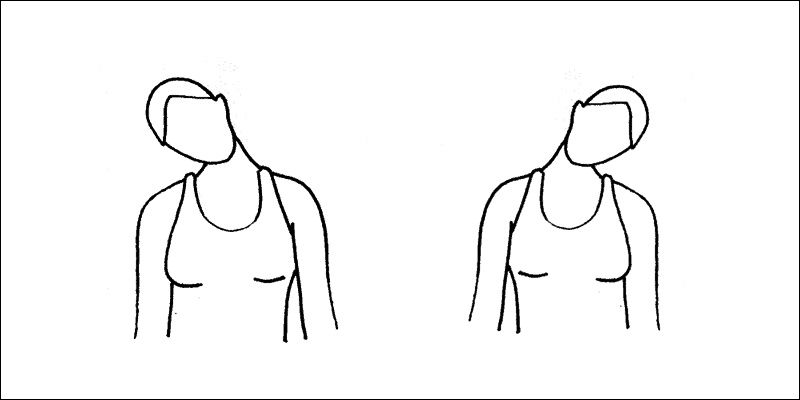
However, this range of motion may be compromised due to the factors previously listed. Hypertonic muscles may pull on a joint or limit movement in the opposing direction (e.g., hypertonic right upper trapezius may limit bending the neck to the left).
Joint fixation, of course, will also alter joint motion. Joint fixation generally does not mean the joint movement is completely inhibited; rather, the movement is limited due to hypertonicity in the joint capsule.
Pain patterns will also contribute to altered range of motion. By itself, pain is a limiting factor due to the unwillingness to move—not because of any mechanical limitation. However, pain may be a result of tissue damage or other issue (e.g., hypertonicity or spasm) which most certainly will cause mechanical limitation.
Normal (approximate) cervical ranges of motion:
- Flexion: 50 degrees; the act of tilting your head down
- Extension: 60 degrees; the act of tilting your head back
- Bilateral rotation: 80 degrees in both directions; the act of turning your neck
- Bilateral lateral flexion: 45 degrees in both directions; the act of side bending your neck
Common mechanism of injury
The undoubted leader in the cause for neck pain in gaming is chronic, poor posture. For example, many of us sit hunched forward when playing, placing our neck in poor positions which can lead to abnormal muscle activation and imbalance.
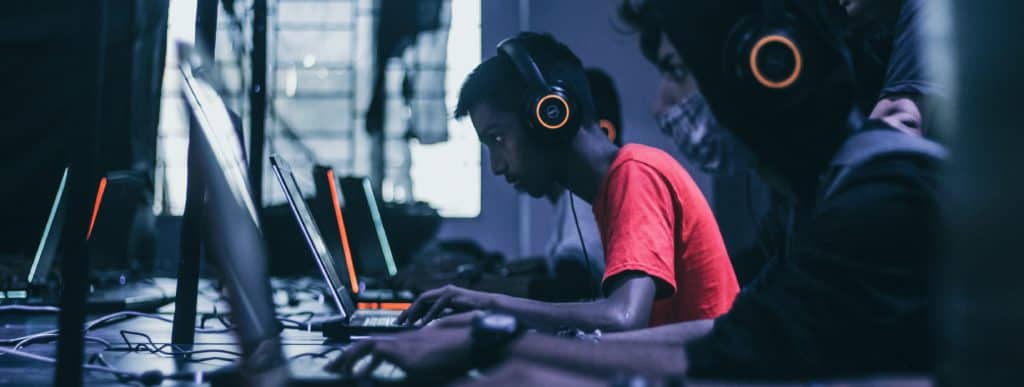
Another common occurrence—more specific to the streaming community—is head and neck rotation due to a dual (or more) monitor setup. Many streamers have their chat on a separate screen than their game, and they will turn their head to read messages and interact with their viewers.
Regardless of anterior head carriage (pictured above) or head and neck rotation to view a separate monitor, these are strained positions that will lead to pain, discomfort, or long-term muscular imbalance.
Muscular imbalance
One of the most common muscular imbalances in the cervical region is also associated with poor posture—known as upper crossed syndrome. The tight or hypertonic muscles in upper crossed syndrome include:
- Pectoralis major
- Sternocleidomastoid
- Upper trapezius
- Levator scapula
The weak or inhibited muscles in upper crossed syndrome include:
- Lower trapezius
- Deep neck flexors
- Serratus anterior
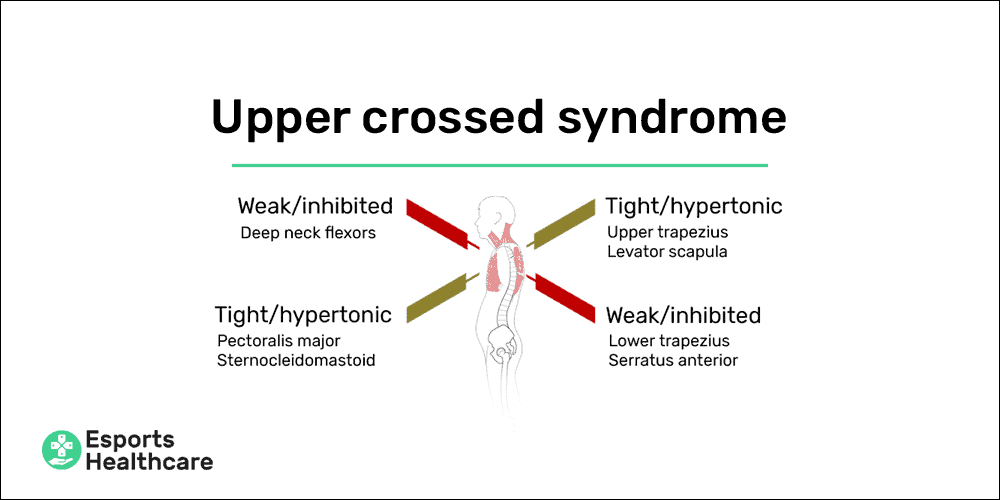
Mental-emotional (psychological) stress
Mental-emotional stress may cause or exacerbate physical ailments—a phenomenon described as psychosomatic (somatic: relating to the body, especially as distinct from the mind). If you have ever experienced a tension-type headache related to stress, you are familiar with both psychosomatic and referred pain.
In one study by Knardahl, the researchers looked at the psychological and social factors that contribute to musculoskeletal disorders and disabilities in computer workers (a profession that is probably most similar to gaming).
In this paper, the author describes the subjective nature of physical pain; ultimately, the pain you feel will almost certainly be different than what someone else may feel in the same situation. In other words, your perception of pain dictates the amount of pain you feel.
Another psychological concern about pain is your thought process—for example, constantly thinking about the pain and its root-cause. Further, you may seek evaluation and treatment and experience little-to-no improvement, therefore leading to more stress which may further increase pain.
Prevention and rehabilitation
Neck pain from gaming is most often a result of poor posture. Therefore, correcting your posture will go a long way to prevent or to resolve any neck pain you may be experiencing.
Sometimes, a simple reminder can help to keep your body in a better position. However, prolonged sitting—especially in a poor position—will create or exacerbate the muscular imbalances described earlier.
When this happens, simply thinking about sitting more appropriately may still be ineffective. So, we developed Power-Up Posture with 21 exercises and stretches to help improve your posture.
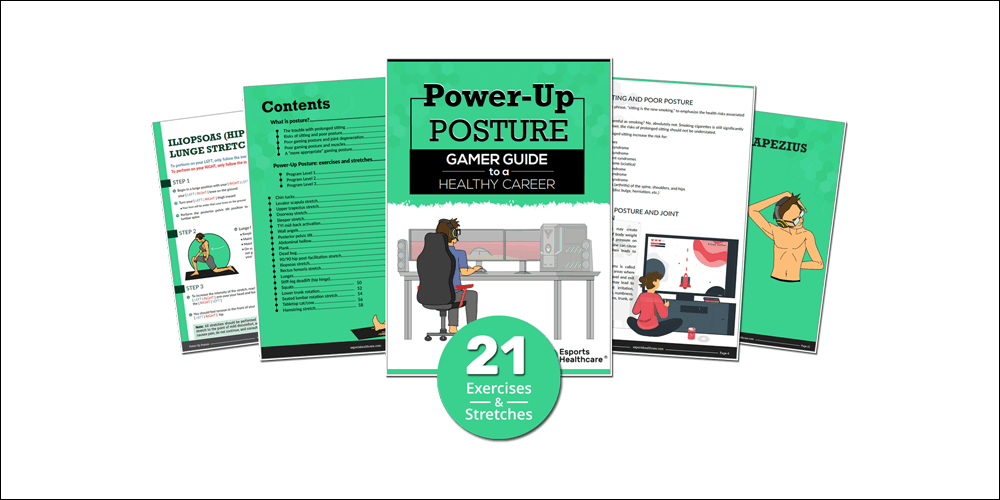
Power-Up Posture is a comprehensive program to stretch and relax the hypertonic muscles and to stimulate activation and strengthening of the inhibited muscles affected by poor posture.
Through participation of this program, you can effectively prevent these muscular imbalances and reduce neck pain from gaming and poor posture.
It is also important to take breaks during your gaming sessions to relieve physical and mental-emotional stress.
As previously mentioned, neck pain from gaming is also associated with stress. Below are a few ways to help manage stress. For more information, check out our mental health section and consider scheduling an appointment with one of our mental health professionals or another professional of your choosing.
- Meditation: guided meditation can be helpful for stress reduction, clarity and body awareness. Meditation guides can be found on phone apps, YouTube videos, or books about meditation
- Yoga asanas: while it is often believed that yoga is mainly stretching, it is more aligned with teaching body awareness, muscle activation, alignment, mental clarity, and balance
- Chiropractic care: chiropractic interventions aren’t just “cracking” joints; although, adjustments can be incredibly beneficial to relieve neck pain from gaming
- Manual therapy and massage: muscular release and relaxation will help to reduce the tension in muscles, which can decrease pain
- Physical therapy: aims to utilize muscular release, primarily through manual therapy, stretching, and exercises to help reduce unnecessary and unwanted strain on the muscles involved
- Exercise: specifically, movements designed to improve posture, muscular balance, an efficient, functional movement



